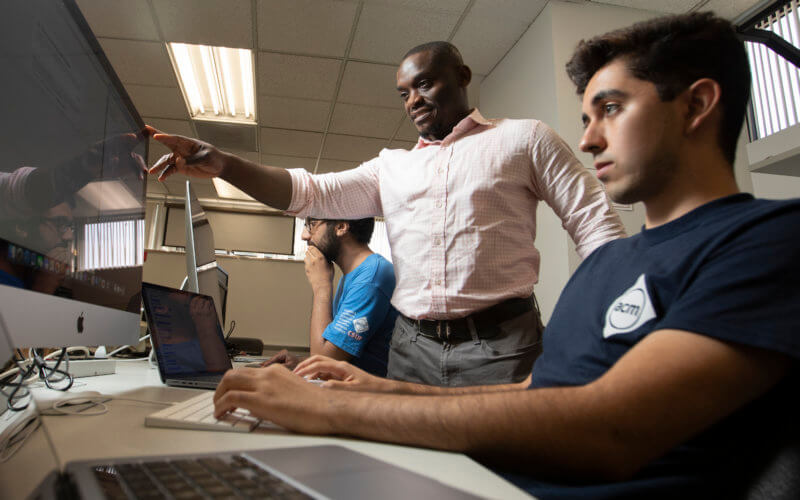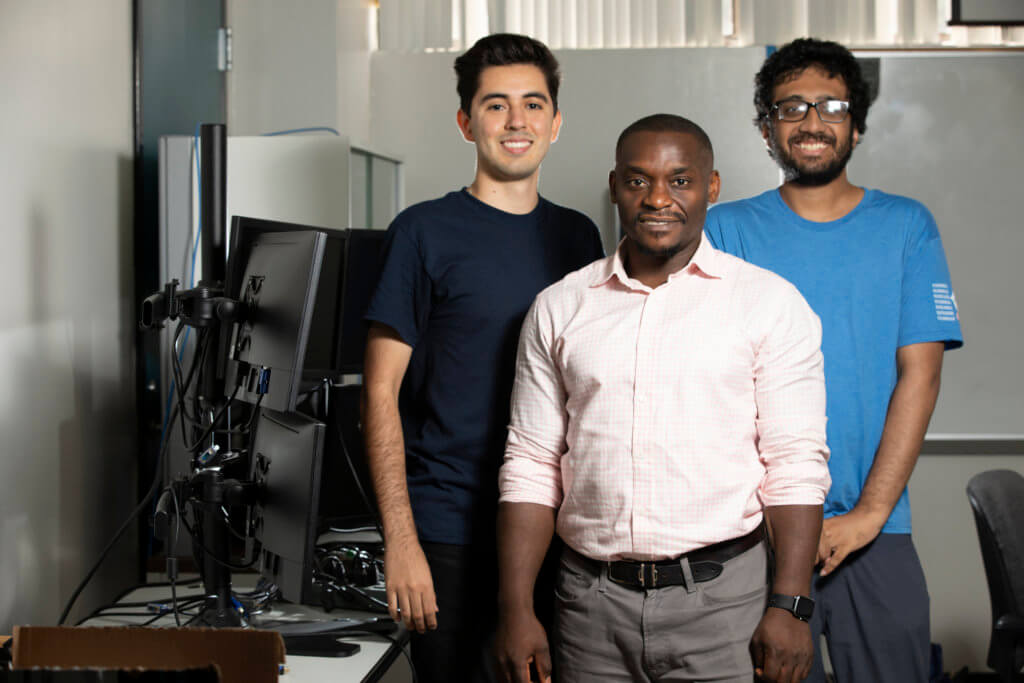
Cal State Fullerton computational epidemiologist Sampson Akwafuo witnessed firsthand how computing tools and techniques can be applied to better understand risk factors of infectious diseases and transmission patterns.
While working with donor-funded public health programs in West Africa, Akwafuo became involved in developing health information systems to collect data and monitor the spread of infectious diseases.
To assist in the global fight against infectious diseases, Akwafuo’s research focuses on computational epidemiology. This new and rapidly growing field develops computational tools for modeling, simulating, predicting and visualizing the spread of diseases in the field of epidemiology, said Akwafuo, assistant professor of computer science.
“It is an emerging interdisciplinary field that uses techniques from different areas of computer science, mathematics, statistics, biology and geo-informatics,” said Akwafuo, who joined the university last academic year. “It will continue to play a vital role in disease monitoring, transmission modeling and simulation of interventions and strategies.”
Akwafuo and his students are currently working on developing data-driven algorithms and modeling and simulation tools for studying disease spread patterns of Lassa fever. The researchers also are applying data mining and machine learning techniques to predict and detect endemics, epidemics and pandemics.
Collaborators on the project are Lohuwa Mamudu, CSUF assistant professor of public health, and the Center for Disaster Informatics and Computational Epidemiology at Georgia State University. Mamudu, a public health epidemiologist and statistician, will assist in several phases of the project, including evaluation and validation of the models in relation to the available real-life data.
Akwafuo plans to expand research efforts to other infectious diseases, including those related to tropical diseases. Previous work has included modeling Ebola and the various intervention strategies for the virus disease.
Preparing Students to Develop Models to Predict Disease Outbreak
Akwafuo’s students are gaining hands-on experience in his Computational Epidemiology, Disaster and Data Intelligence Lab and through course-related activities to prepare for careers as computational epidemiologists.
“The demand for computational epidemiologists is huge. They can work at the various laboratories and out-stations of the Centers for Disease Control and Prevention. They can be deployed through the foreign public health missions, to most-at-risk countries, or work at county and state health departments,” he said.
International agencies like the United Nations and World Health Organization also are looking for such multidisciplinary professionals.
Computer science majors Ali Hussain and Daniel Quezada are among Akwafuo’s research students working to visualize and track how outbreaks of Lassa fever would spread through an affected community over time.

Hussain’s interest in disease outbreaks and disaster response piqued when the COVID-19 pandemic hit.
“What specifically captivated me during that time was the ‘flattening the curve’ strategy that the public was made aware of in efforts to slow down the spread of the disease,” said Hussain, who plans a career in the field after he graduates next year.
“It captivated me how such a simple strategy can be so effective in mitigating a pandemic. Ever since, I’ve become more and more fascinated with how technology can improve on conventional epidemiology.”
Lassa Fever: The Next Pandemic?
Lassa fever, named after the town in Nigeria where the first cases occurred over 50 years ago, is endemic — the constant presence of a disease — in parts of West Africa. Over the last two two years, there has been a major increase in the number of cases, said Akwafuo, originally from Nigeria. It’s also personal since he has lost two friends, who were health care practitioners, to the disease.
“It is worrisome that a substantial rate of Lassa fever cases in Nigeria occurs among the health care workers,” he added.
Lassa fever, similar to Ebola or yellow fever, spreads to humans through contact with food or household items that have been contaminated with rodent urine and droppings or from an infected person to another. The disease is characterized by high fever and inflammation of various body parts, has a hospital mortality rate of up to 20% and there is no vaccine or vaccine candidate available.
While recent Lassa fever outbreaks have occurred mostly in West Africa, some cases and deaths also have been reported in the United States, according to the CDC. Gavi, the global vaccine coalition, has hinted that Lassa fever might be the next pandemic, Akwafuo noted.
Prediction of disease outbreaks is a critical task for public health policymakers and epidemiologists. Having a tested and reliable predictive model is vital for effective preplanning of public health response operations, impact reduction and outbreak containment.
“Our research entails developing efficient and reliable machine learning and algorithm models for predicting possible disease outbreaks in a locality of interest,” Akwafuo said. “Predicting an outbreak at the source will significantly reduce, or prevent, the potential global circulation of the disease — and help in saving lives.”
Quezada learned about the field as a student in this summer’s Project RAISE undergraduate research experience for community college students and worked on Lassa fever predictive modeling with Akwafuo. He transferred to CSUF this fall semester and is continuing to work on the project.
“Infectious diseases don’t go away on their own. Lassa fever is no exception,” said Quezada, a junior who wants to pursue a career as a data science developer.
“Lassa fever might be the next pandemic, so it’s important that we identify strategies that can help reduce the transmission of Lassa fever between hosts. If we can identify these strategies and work with public health officials in implementing policies in countries affected by Lassa fever, we stand a chance in preventing the disease from becoming a pandemic.”